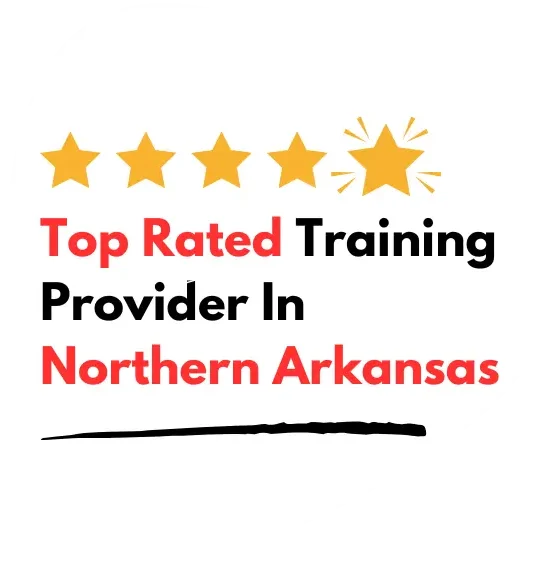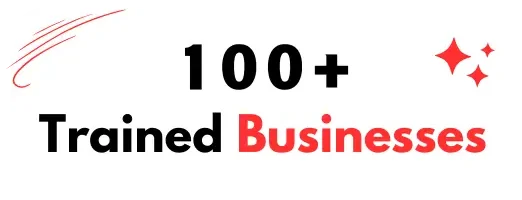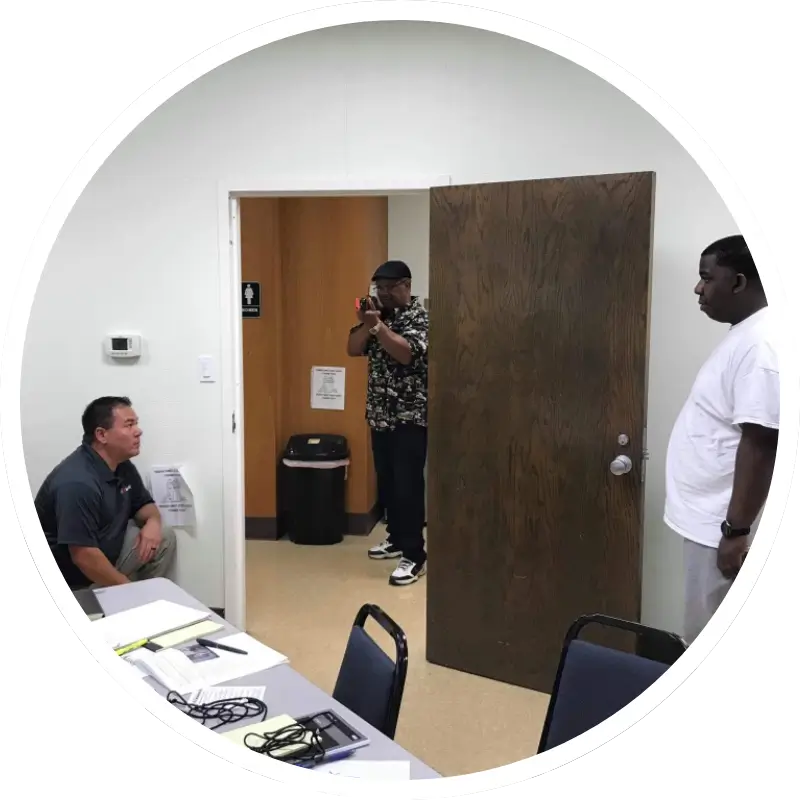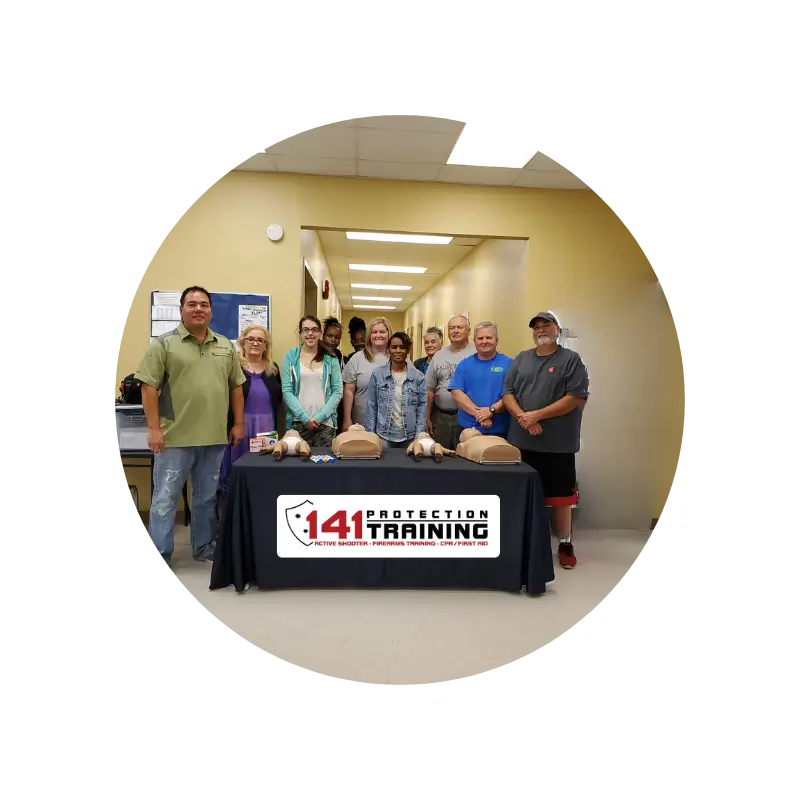Quick Links
© Copyright 2023 141 Protection Training. All right reserved. Developed by Muhammad
Our Active Shooter training in Arkansas provides critical skills for effectively responding to active shooter situations. Participants learn to recognize potential threats, implement safety protocols, and react swiftly to ensure safety. Through realistic drills and expert guidance, we empower individuals and organizations to handle emergencies with confidence and preparedness.




141 Protection Training offers comprehensive active shooter training for individuals and groups. The training emphasizes risk assessment, situational awareness, and Escape, Barricade, and Defend.
Participants learn how to communicate with law enforcement, help colleagues in crisis, and self-care after an event. Participants learn through classroom and hands-on exercises to apply their real-life skills.
The training suits businesses, schools, hospitals, and government bodies of all expertise levels. Expert-led training improves safety and preparation. With flexible enrollment and extensive training materials, 141 Protection Training’s Active Shooter Training Program helps individuals respond to active shooters and makes the neighborhood safer.
Active Shooter Training provides numerous benefits for Arkansas residents and organizations. This training equips individuals with the skills to effectively handle an active shooter situation. The course covers communication, situational awareness, and coordination with law enforcement.
This course suits participants at any stage of their safety and security careers, regardless of their experience level. It is also suitable for businesses, schools, hospitals, and government agencies of all sizes and industries.
If you need additional information then please click on phone/email button for direct call/email.

Participants in the Active Shooter Training receive comprehensive course materials, which include:
The Active Shooter Training program covers a range of critical topics, including:
If you need additional information then please click on phone/email button for direct call/email.
About Us
141 Protection Training provides active shooter training that prepares individuals and organizations for active shooter crises. Given the growing frequency of these dangers, it is imperative to prioritize readiness. Our extensive training covers situational awareness, proficient communication with police enforcement, and the Defend-Fight technique. Businesses, educational institutions, healthcare facilities, and government agencies can all benefit from 141 Protection Training’s active shooter training. Our curriculum guarantees that all participants, regardless of proficiency, receive the assurance and expertise necessary to respond efficiently. This program aims to mitigate, anticipate, and promptly address active shooter occurrences.



At 141 Protection Training, we incorporate realistic scenarios and role-playing into our active shooter training exercises. This hands-on approach helps individuals develop practical skills and confidence, allowing them to react effectively during an incident.
Our training emphasizes team-based drills that foster collaboration and communication among participants. Coordinating employee actions in simulated emergencies enhances workplace safety.
It is crucial to understand how active shooter events affect the psychological well-being of the victims. Under pressure, we teach individuals stress management techniques to help them maintain their composure. In high-stress situations, these techniques ensure a calm and effective response.
We go beyond immediate responses to provide a comprehensive approach. Post-incident recovery and debriefing training ensures participants know how to support each other and manage the aftermath of an event. This holistic approach can help individuals and organizations recover emotionally and psychologically.
141 Protection Training’s active shooter training prepares employees to respond effectively during emergencies. In a crisis, this preparedness will ensure that individuals know how to act quickly and efficiently, saving lives and minimizing injuries.
Implementing active shooter training demonstrates a commitment to employee safety and fosters a culture of vigilance and preparedness. This proactive approach results in employees feeling valued and protected in the workplace.
Employees gain confidence in handling emergencies by undergoing active shooter training. Confidence that they can protect themselves and their colleagues improves individual performance and team morale.
The provision of active shooter training helps businesses meet legal and regulatory requirements, reducing potential liability. Organizations can avoid costly legal repercussions by adhering to safety standards and protocols in the event of an incident.
We emphasize the importance of clear communication and coordination during emergencies. Employees who learn to relay critical information and work together seamlessly enhance the response’s efficiency and effectiveness.
After an incident, 141 Protection Training covers post-incident recovery, ensuring employees can support one another. In addition to facilitating emotional and psychological recovery, this comprehensive approach helps the organization and its people move forward.
Active shooter escape involves rapidly and securely leaving the location. Participants learn to find several exits and leave stuff behind to escape faster. Training goals include moving swiftly, remaining low, and avoiding windows and exposed spaces. Employees can act quickly by understanding the need for a clear path and conducting drills.
Barricade educates employees on how to remain safe if escape is impossible. This involves barring doors, blocking entryways with heavy furniture, and shutting off lights to simulate a space. Participants learn to build walls and stay quiet to avoid discovery. This tactic buys crucial time while law enforcement arrives.
Defend uses last-resort methods when escape and barricading fail. Participants study self-defense and how to incapacitate the gunman using improvised weapons. Training encourages teamwork to defeat the aggressor. Although a last resort, these talents can save lives and avert future injuries.
Discovering odd behavior is the first step in recognizing risks. This involves noticing worried, irritated, or disoriented people. Staff needs to report suspicious behavior to prevent problems from escalating.
Watching for violent utterances is verbal threat monitoring. This might involve threats, gun talk, or hostility toward specific people or groups. Training stresses the significance of taking such statements seriously and reporting them to authorities promptly.
Identifying indications of isolation can help identify people with personal concerns that could escalate to violence. Employees learn to spot changes in behavior like social withdrawal or job disinterest. Early intervention may avoid and assist an occurrence.
Observing appearance changes entails noticing substantial changes in dress, grooming, or presentation. Drastic changes may indicate discomfort or intimidation. An employee’s behavior evaluation includes recognizing these changes as red flags and reporting them.
An individual who has an abnormal interest in firearms or other forms of violence might be diagnosed with weapon fixation. Conversations, drawings, and internet activity can show this. Training teaches employees to disclose fixations to prevent workplace firearm acquisition and usage.
Documentation and reporting are essential for workplace safety. Employees learn to document suspicious activity and report it to authorities correctly. This comprehensive technique gives investigators all essential information and prevents active shooter scenarios.
The Active Shooter Training Program prepares individuals and organizations for active shooter incidents through comprehensive instruction and hands-on exercises.
The program is open to individuals at all experience levels, including businesses, schools, hospitals, and government agencies.
The program covers situational awareness, threat recognition, the Hide Fight method, communication with law enforcement, and post-incident self-care.
The program’s length varies, with full-day and half-day sessions available to accommodate participants’ schedules.
You don’t need any prior experience; all experience levels are welcome to the program.
Participants receive workbooks, course manuals, response checklists, and access to online training resources.
The program aims to equip participants with the knowledge and skills to respond effectively to active shooter situations.
© Copyright 2023 141 Protection Training. All right reserved. Developed by Muhammad